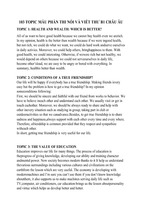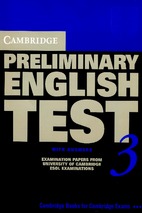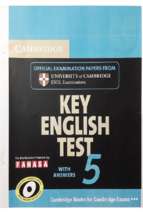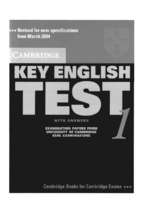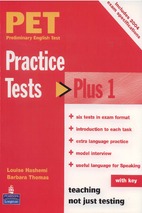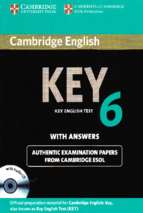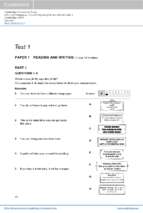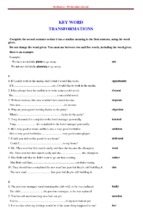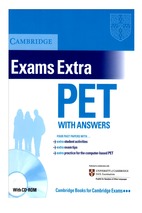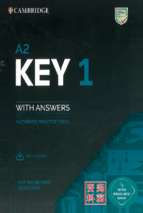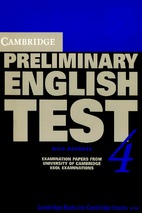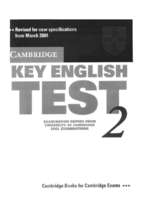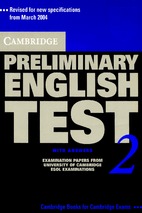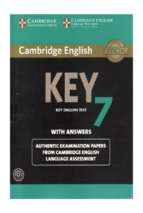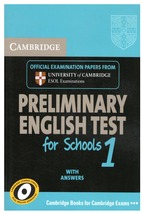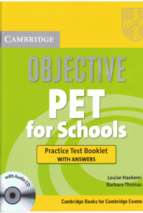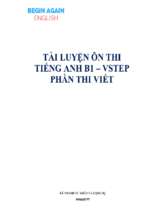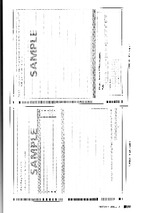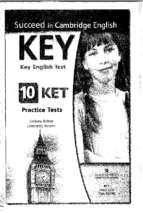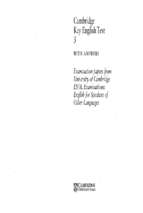English
Unlimited
A1
Starter
Teacher's Pack
Adrian Doff
iWi
CAMBRIDGE
UNIVERSITY PRESS
Acknowledgements
Adrian Doff would like to thank Karen Momber and Keith
Sands at Cambridge University Press for overseeing the
project and for their invaluable help and support throughout
the development of this course. He would also like to thank
his editor, Andrew Reid, for his commitment and hard work
and help in bringing the book into its final form.
He would like to thank Dr Astrid Krake and Donna
Liersch at the Volkshochschule Mtinchen for giving him an
opportunity to teach there and try out new ideas.
He would also like to thank Gabriella Zaharias for
consistently supporting and encouraging him during the
writing of this book.
Johanna Stirling would like to thank her colleagues
and students for all their help and inspiration. She also
acknowledges the contribution of those in her online social
network who often rallied to the cry of help. Thanks to
Andrew Reid for simplifying the over-complicated. Above
all, she would like to thank Daryl for his unfailing support
and for doing more than his fair share of the washing-up.
Rachel Thake and Cathy Brabben would like to thank their
colleagues and students in the ESOL department at Thames
Valley University, Reading Campus, for their help and
support with Writing Essentials. Special thanks go to Mary
Langshaw, Angela Buckingham, Sue Laker and Sue Allan.
Mark Lloyd would like to thank the teachers and staff of IH
Bath/WELS Bath for their suggestions and ever-constructive
criticism, as well as all those students who have, knowingly
or otherwise, acted as enthusiastic guinea pigs. Above all,
however, he would like to thank Rosa - for her patience and
for doing far more than her fair share of the parental duties
- and Gabriela, for her smiles and giggles!
The authors and publishers are grateful to:
Text design and page make-up: Stephanie White at
Kamae Design
Video content: all the team at Phaebus Media Group
Video scripts: Nick Robinson
Illustrations by:
Mark Duffin, Clare Elsom, Paul Moran and Kathy
Baxendale.
The authors and publishers acknowledge the following
sources of copyright material and are grateful for the
permissions granted. While every effort has been made,
it has not always been possible to identify the sources of
all the material used, or to trace all copyright holders.
If any omissions are brought to our notice, we will be
happy to include the appropriate acknowledgements on
reprinting.
For the tables on the DVD-ROM and the text on pages 4 and
20 of the Teacher's book © Common European Framework
of Reference for Languages: Learning, teaching, assessment
(2001) Council of Europe Modern Languages Division,
Strasbourg, Cambridge University Press
Contents
Introduction
The thinking behind English Unlimited
4
Unit map
6
A detailed look at the features of English Unlimited
11
The Self-study Pack
15
The Teacher's Pack
16
Assessing your learners with English Unlimited
17
The Common European Framework of Reference for Languages (CEF)
19
Teaching notes
Unit 1
20
Unit 2
28
Unit 3
35
Unit 4
43
Unit 5
50
Unit 6
58
Unit 7
66
Unit 8
73
Unit 9
79
Unit 10
86
Writing Essentials
93
Contents
3
1Hello
Unit goal: talk to someone for the first time
1.1
Goals: talk to someone for the first time
introduce yourself
say where you are from
ask people where they are from
Core language:
VOCABULARY Hello, I’m …; I’m from …; my, your
My name is …; What’s your name?
Countries: England, Russia, China; the USA
GRAMMAR
be present – questions: Are you …?; Are you
from …?; Where are you from?
A your; My
B I’m; I’m
C your; your; My
Check that learners know new and teacher.
To demonstrate the meaning of Nice to meet you, say
hello to a learner. Shake his / her hand and say:
Nice to meet you. You could give an equivalent in
learners’ own language, or ask them for one.
c Short forms. Look at the table and say both forms to
make the difference clear. Then play recording 1.3
(or say the sentences yourself) and get learners to
repeat. Focus on the stress pattern of:
– What’s your name?
I’m ...
Language note
VOCABULARY Hello, I’m ..., My ...
It isn’t essential to use short forms, but they are very
common in spoken English, especially I’m.
Optional lead-in with books closed
Introduce yourself to the class. Say I’m (John). a few times.
Point to yourself to show the meaning of I. Say to one
learner: Hello. I’m (John). Get the learner to give his / her
name in the same way. Go round the class, getting learners
to give their names, using I’m … .
Write on the board: I’m John. = I am John.
Say both sentences to show how I’m is a short form of I am.
Introduce yourself again. This time say My name is (John).
Say a few common names to show what name means.
Go round the class, getting learners to give their names,
using My name is … .
1 a Presentation of ‘I’m …, My name is …; Hello. Hi.’
Look at the photo and play recording 1.1. Ask learners
what words go in the gaps.
Hi. I’m Carlos Puente.
Hello. My name is Peter Newman.
b If they haven’t already done so, get learners to give
their own names, using the same expressions.
LISTENING
2 a Numbers 1–3. See if learners know the numbers. If
not, say them and learners repeat. Play recording 1.2.
Pause after each conversation and ask learners to say
which photo it is.
A2
B3
C1
Optional extra
Use the photos to teach school, café and airport. Ask Where
is it? to elicit the words. Write them on the board.
b Presentation of ‘My, your; What’s your name?’. To
teach your and the question What’s your name?, point
to yourself and say My name is (John), then point to
a learner and say Your name is (Ali). Then ask a few
learners What’s your name?.
/
Learners read conversations A, B and C and fill
in the gaps. If necessary, play the recording again to
check.
20
Unit 1 Hello
SPEAKING
3 a
Learners read the sentences and choose the best
order. Go through the answers together by listening to
recording 1.4.
1 Hello, I’m Luis. 2 What’s your name?
4 Hi, Ali. 5 Nice to meet you.
3 I’m Ali.
b Mingling activity. To demonstrate, choose one learner
and have a conversation. Then have a conversation
with a second learner, getting him / her to ask you
What’s your name?.
Learners move freely round the class, introducing
themselves and asking other learners’ names.
Alternative
If it is difficult for learners to move freely around the class,
you could ask them to stay in their seats and talk to the
people around them.
I’m from …
VOCABULARY Countries
1
Presentation. Play recording 1.5 or say the names of
the countries. Ask learners to identify them.
A China
B the USA
C England
D Russia
Learners repeat the countries. Focus on the
pronunciation of /ju: es eI/, and the /@/ sounds in
/Iŋl@nd/, /rS@/, /tSaIn@/. You could also practise
/lnd@n/ and /mɒsk@υ/.
GRAMMAR Questions
2 a Presentation of ‘I’m from ...’. Look at the picture and
play recording 1.6. Establish what the people say:
1 I’m from the USA. I’m from New York.
2 I’m from England. I’m from London.
Get learners to repeat the sentences. Focus on the
pronunciation of /frəm/.
Optional extra
Ask learners where the people in the picture are. Use this to
teach plane (or on a plane) and passenger.
b Presentation of ‘Are you (from) …? Where are
you from?’. Play recording 1.6 again. Learners say
questions in the correct order. Write the questions on
the board.
Classroom language:
Letter, word, sentence ...
Goal:
Core language:
letter, word, sentence, number, question
1 Vocabulary. Use the examples to establish the
meaning of the words.
2 a question 3 a word 4 a letter 5 a number
Alternative
Ask learners what the questions are. Then play recording 1.6
again to check.
To show how the word order changes in questions,
write on the board:
1 2
2 1
– You are from England → Are you from England?
Point out that you and are change round.
Look at the table. Read through the examples.
You could give other sentences and learners make
questions:
– I’m a teacher. → Am I a teacher?
– You are here. → Are you here? Where are you?
c Practice of questions and answers. Look at the speech
bubbles and learners say the questions and answers.
1 – Where are you from?
– (I’m from) China.
2 – Are you from the USA?
– Yes, I’m from Miami.
3 – Are you from China?
– No, I’m from the USA.
4 – Where are you from?
– (I’m from) London.
Go through the answers together by listening to
recording 1.7.
Learners ask and answer the questions.
SPEAKING
3 a Writing. Ask learners: Where are you from? Check
that they can say their country correctly. Write the
country name(s) on the board for learners to copy.
b Ask each question to two or three different learners
round the class. Expected answers:
1 No. I’m from (Japan).
2 I’m from (Japan).
3 I’m from (Tokyo).
c Get learners to ask you the questions. Give true
answers.
Learners ask and answer the questions in pairs.
Instead of I’m from London, they should give their
own home town.
Alternative: Mingling activity
Learners move freely round the class, asking and answering
questions.
to understand simple words needed to use the
Coursebook
Focus on the pronunciation of the words, especially
the reduced vowels in /sent@nts/ and /kwestS@n/.
Optional practice
If necessary, write other examples on the board to make the
meanings clear. Show that:
– �a sentence starts with a capital (big) letter and ends in a full
stop (.)
– �a question starts with a capital (big) letter and ends in a
question mark (?)
Learners could find examples of sentences and questions in
the Coursebook.
2
Practice. Learners do the exercise.
1 word 2 number 3 sentence 4 letter 5 question
6 letter 7 number
Language note
You could point out that P is a capital letter (or big letter) and m
is a small letter. Write capital letter and small letter on the board.
1.2
Goals: talk to someone for the first time
ask and say where places are
say where you live
Core language:
VOCABULARY flat, apartment, house, room, car
big, small, nice
in, near (London)
GRAMMAR
a / an: a (flat), an (apartment)
be present: It’s …, Where is …?
Present simple – positive: I / We + verb
Where is it?
GRAMMAR It’s …, Where is ...?
1 Presentation of ‘It’s .. (It is ...); I think ...’ Look on p86
of the Coursebook. Look at photo A and ask:
– Where is it? (England, or London).
Show the full and short forms of It is on the board:
– It is ... → It’s …
Then add I think:
– I think it’s ...
Show the meaning of I think with gestures. Get
learners to practise saying the sentence. You could
help them with the stress pattern by ‘back-chaining’:
– England → It’s England. → I think it’s England.
Learners look at photos B–H and guess the
countries, making sentences with I think it’s ... .
Unit 1 Hello 21
A England B the USA C Russia D the USA
E the USA F China G Russia H China
2 a Presentation of ‘Where’s ...? (Where is ..?) I don’t know’.
Books closed. Ask: Where’s Manchester? (It’s in
England.) Write the full and short forms on the board:
Where is ...? → Where’s ...?
Practise asking the question, using different places:
– London → Where’s London?
– Beijing → Where’s Beijing?, etc.
Open books. Look at the city names in the box. Give
possible answers for one item, e.g.
– Where’s Shanghai?
– I don’t know. / It’s in China. / I think it’s in China.
Show the meaning of I don’t know with gestures.
Shanghai: It’s in China.
Miami: It’s in the USA.
Novosibirsk: It’s in Russia.
Beijing: It’s in China.
Oxford: It’s in England.
Los Angeles: It’s in the USA.
Moscow: It’s in Russia.
Manchester: It’s in England.
b Read the full and short forms in the table or play
recording 1.8. Show on the board how we use an
apostrophe (’) to show that a letter is missing. Practise
saying the short forms.
Language note
We usually use short forms (It’s, Where’s, etc.) in
conversation, but not always. It is important for learners to
understand them, but don’t insist on them using short forms
themselves at this stage.
After some nouns, it isn’t possible to use a short form, e.g.
Paris is ..., Los Angeles is ... .
Big, small ...
VOCABULARY big, small
1 Presentation of ‘(It’s) big, small; (It’s a) house’. Look
at the picture and ask What is it? (a house). Then ask:
Is it big or small? (big). Use gestures to show the
meaning of big and small.
2 a Presentation of ‘It’s a big house.’ On the board, write:
It’s a house. Then show how we can add big:
– It’s a big house.
Read the sentences or play recording 1.9. Ask learners
to repeat. Make sure that they say It’s a house and
It’s a big house (not just It’s big house). Make sure
they say a as /@/.
Language note
For many learners, the use of a will be the same as in their
own language.
If learners have no article system in their own language, tell
them that a = ‘one’.
b Look at the pictures on page 86. Use the pictures
to present car and room (point to a picture and ask:
What’s this?).
Learners take it in turns to choose a picture and say
a sentence.
22 Unit 1 Hello
I live …
READING
1 Presentation of ‘flat, apartment; a/an’. Look at each
photo. Ask: What is it?. Use this to present flat and
apartment. Ask if they are big or small.
A It’s a flat (an apartment). It’s small.
B It’s a flat (an apartment). It’s big.
C It’s a house. It’s big.
Language note
Flat is British English; apartment is US (and also international)
English. They mean the same.
Point out that we say an apartment. This is because
apartment begins with the sound ‘a’ (a vowel). If
necessary, show that it is difficult to say a apartment,
so we add /n/.
Note
Don’t give a detailed presentation of a / an at this point. It is
presented in Unit 4.2.
b Learners read the sentences and match them with the
photos. Then they fill in the gaps.
1 B – an apartment
2 C – a house
3 A – a flat
If necessary, quickly present live and have (it should
be clear from the context), but wait till 2 to focus on
these verbs.
c Play recording 1.10.
d Learners cover the sentences in 1b and listen again
(either play recording 1.10, or read them aloud). Then
ask the questions round the class.
Photo A – It’s a flat. It’s very small. It’s in Paris.
Photo B – It’s an apartment. It’s big. It’s in Dubai.
Photo C – �It’s a house. It’s near Naples. It’s a town in
Florida, in the USA.
Sentences covered. Learners ask and answer the
questions.
GRAMMAR I / We + verb
2 a Presentation of ‘I have, We have, I live, We live’. Give
examples about yourself to present the meaning of
live and have, e.g.
I live in (Rome). I have a house.
I live in a house in (Rome) / I have a house in (Rome).
To show the meaning of we, say I live in (Rome), then
stand with a learner and say We live in (Rome).
Read the sentences in the table. Ask learners to
repeat I live, we live, I have, we have, to check
pronunciation. Alternatively, ask learners to read the
sentences aloud. Check learners say /lIv/ not /li:v/ and
/hv/ not /hf/.
b /
Learners write live or have in the gaps.
1 have 2 live 3 have 4 live 5 live 6 have
LISTENING
3 Read the sentences and look at plans A and B. Then
play recording 1.11 and go through the answers.
3 a Play recording 1.14. Learners listen and underline
the words they hear. Check the answers and play
recording 1.14 again if necessary.
Hi
it’s
I’m
in
Paris
1 Yes. 2 No (in Berlin). 3 No (it’s very small). 4 Yes.
It’s Flat A (one room and a kitchen).
If necessary, play recording 1.11 again.
WRITING
4 a To show what to do, write or say a few sentences
about your own house / flat.
Learners write sentences about their house or flat.
While they are writing, go round and check.
b A strong pair of learners have the conversation in
front of the class. Check pronunciation.
Learners have a similar conversation, but use their
own name and choose a different place.
Note
1.3
If learners all live in the same town, ask them to write what
part of town they live in.
If they live alone or have their own house / flat, they should
write I have. If they live with their parents or family, they
should write we have.
Goals: talk to someone for the first time
ask and say if you are married
say if you have children
b
Speaking. Learners tell their partner about their
house or flat.
Core language:
VOCABULARY
GRAMMAR
Optional practice
1 Mingling activity
After writing, learners move freely round the class. They tell
two or three other learners about their house / flat.
2 Writing for homework
Learners do this as a speaking activity and write the
sentences for homework.
3 Add a photo
Ask learners to find (or take) a photo of their house or flat
and add it to their sentences.
Numbers: 0–10
boy, boys; girl, girls; child, children
Family: no (children) = ‘not any’, married
be present – negative: I’m, I’m not;
we’re, we’re not
Numbers
VOCABULARY Numbers 0–10
1 Presentation of numbers 0–10. Learners say the
numbers. If necessary, say them (or play recording
1.15) and get learners to repeat.
Option: Stronger classes
Sounds and spelling: The letter i
Goal:
to recognise and pronounce the letter i with the
sounds /I/ and /aI/
Core language:
Words from Unit 1 with the letter i
1 /I/ and /aI/. Say the words or play recording 1.12.
Focus on the two sounds:
– �/I/ is said with lips neutral, not spread (it has a lower
quality than in many languages).
– �show how /aI/ is formed from /a/ + /I/. Get learners to
say the sounds separately. Then run them together.
2
/
Learners put the words in the correct group.
Go through the answers together by listening to
recording 1.13.
/I/
/aI/
it
in
big
five
China
I’m
Learners may already know the numbers. Check this with
books closed: write the numbers on the board, and learners
say them. Then write the words. Focus on any that learners
aren’t sure of.
Focus on the sounds /wn/ and /Tri:/.
Language note
To help students say /T/, get them to say /t/, and notice
where their tongue touches their top teeth. Then get them
to make less contact, so air can pass their tongue and their
teeth. This should produce a /T/ sound.
Look at the words in the box. Learners read them
aloud. Then learners write the numbers with the words
beside them, in order.
To practise, say a number and learners say the next
one. They could also do this in pairs.
2
Learners cover 1 and practise saying the numbers
in A–F. Then go through the answers together.
Language note
All these numbers would normally be said as separate digits
in English. 0 can be said as zero or oh.
Language note
Words with the spelling pattern i...e (five, nice) usually have
the sound /aI/. Live (as a verb) is an exception because it is
pronounced /lIv/. Point this out to the class, if necessary.
Unit 1 Hello 23
Alternatives
1 Say a number. Learners write it down (as a figure, not a
word). Then learners read the numbers back to you. You
could also do this with phone numbers.
2 Say sequences and learners continue them:
– 1, 2, ...
– 2, 4, ...
– 1, 3, ...
– 10, 9, ...
– 10, 8, ...
3 To practise writing numbers, say a sentence with numbers
in them. Learners write only the number they hear (as a
word), e.g.
– I have three children.
– It’s bus number seven.
– My flat is number five.
Families
VOCABULARY boy, girl ...
1 a Presentation of vocabulary. Look at the picture and
see if learners know the words (boys, a girl, etc.).
If not, read them out or play recording 1.16 and ask
learners to repeat. You could also ask questions, e.g.
– Look at C – a boy or boys?
Use this to present plurals. Write boy and girl on the
board, and say the words. Then add -s and say boys
and girls. Get learners to repeat the singular and plural
forms (check that they pronounce the -s as /z/). Point
out that:
– to make a plural, we usually add -s.
– children is irregular.
Listening. Play recording 1.16. Learners listen and say
the expression they hear.
A two boys B a girl C three girls D a boy
E seven children
b
Learners take it in turns to point to a picture. The
other learner says what it is.
GRAMMAR I’m not, we’re not
2 Presentation of ‘ married, no (children)’. Read the
sentences to the class or play recording 1.17. Ask the
class to find the picture.
1 C 2 E 3 A 4 D 5 B
As you go through, present married by showing or
gesturing to a wedding ring and show on the board
that no children = ‘0 children’.
3 a Presentation of ‘I’m not, we’re not’. Write on the
board: I’m married. We’re married. Then add not, to
show how to make the sentences negative.
Say the sentences in the box or play recording 1.18 as
a model. Ask learners to repeat.
Tell the class I’m married (or I’m not married). A few
learners round the class say if they are married or not
married.
b /
Learners add words to the gaps. Go through the
answers together by listening to recording 1.19.
1 girl 2 married; children 3 child 4 have; girls
24 Unit 1 Hello
4 Speaking. Look on page 87. To show how the game
works, say a few different sentences and learners say
the picture, e.g.
– I’m married. We have two boys. (2)
– I have one girl. (1)
Learners take it in turns to say a sentence. The
other learner guesses the picture.
Alternative: Whole class activity
Do this with the whole class together. Learners take it in
turns to say a sentence. The other learners guess the picture.
5 Writing. Show what to do by writing two sentences
about yourself on the board.
Learners write true sentences. As they do this, go
round and check. A few learners could read out their
sentences.
Alternatives
1 Younger classes
If none of your learners are married or have children, get
one learner to come to the front and the others tell him /
her what to write:
– I’m not married and I have no children.
2 Mixed adult classes
If your class has a mixture of learners (married and
unmarried, with and without children), you could do this as
a speaking activity in pairs, or as a mingling activity, with
learners moving freely round the class.
Target activity: Talk to someone
for the first time
Goal:
Talk to someone for the first time
Core language:
1.1 VOCABULARY
1.3 VOCABULARY
1.1 Grammar
1.2 grammar
Hello, I’m, my …
boy, girl
Questions
I / We + verb
TASK LISTENING
1 a Preparation for exercise 1b. Read the expressions and
ask learners to suggest what the people say.
I’m / My name is Mark.
I’m from the USA.
I live in / near London.
I have / live in a small apartment.
I’m not married.
I’m / My name is Claudia.
I’m from / I live in Brazil.
I have / live in a flat in São Paulo.
I’m married.
I have two sons.
To focus on the word son, tell the class: I have one
child – a boy. So he is my son.
If you like, teach daughter in the same way.
b Listening. Play recording 1.20. Pause from time to
time to check what the speakers actually say. Don’t
focus on the questions at this stage.
c Writing. Establish what the questions should be.
Either do this together, or let learners work alone or in
pairs, then go through them together:
1 What’s your name?
2 Are you married?
3 Where are you from?
4 What about you?
If necessary, play recording 1.20 again to check.
Alternatively, play it and let learners follow the script
on p120.
TASK
2 a Role play. To show what to do, take the role of either
Mark or Claudia. Choose a strong learner and have a
conversation (the learner should be him/herself). Then
choose another learner. This time, the learner should be
either Mark or Claudia and you are yourself.
Learners have conversations in pairs. One learner
takes the role of either Mark or Claudia (depending on
whether they are male or female) and the other learner
is him / herself.
b Learners change roles and have a second conversation.
Learners could change partners to do this.
Optional extra
Divide the class into A and B learners. Tell the class that they
are at an airport.
A learners stay in their seats. B learners stand up and move
around. Then, B learners find an A learner to sit next to. They
have a conversation. Next, B learners move to a different seat
and have a conversation with a different A learner.
Continue until most of the class have had a chance to
introduce themselves to each other.
You could use photocopiable activity 1A on the
Teacher’s DVD-ROM at this point.
Keyword this
Goal:
identify things in a picture or a room
Core language:
This is ...
What’s this? It’s ...
mother, father, bed, desk, door, window, picture, room, chair
1 Presentation of ‘This is ...’. Look at the pictures and
check that learners understand mother and father.
Play recording 1.21 and ask what Sophie says. Write
This is ... on the board. To make it clear how we use
This is ..., give examples using gestures, e.g.
– point to a learner and say This is (Maria).
– show your Coursebook and say This is my book.
2 a Vocabulary. Go through the words in the box and
point to the things in the picture or in the classroom.
Say This is a door, etc. If necessary, play recording
1.22. Ask learners to repeat the words and focus on
the pronunciation of /dO:/, /tSε@/ and /pIktS@/.
b Practice of ‘This is’. Learners practise saying sentences
with This is. Prompt them by saying a door, a window,
etc.
Optional practice
Ask learners to repeat this is. Point out that both words have
a short /I/ sound. If learners say /Di:s i:z/, ask them to open
their mouth more loosely and lower their tongue slightly.
If learners have problems with /D/, ask them to say /d/, then
let the air pass between the tip of their tongue and their
mouth. This should produce a /D/ sound.
3 Practice of ‘What’s this?’. Point to things in the
picture and ask What’s this? Learners should answer
It’s a (door).
Learners cover the words and ask and answer
questions.
Learners could point to the same things in the room.
Optional extension
Use This is ... to teach other things in the classroom, e.g.
a book, a bag, a pen, paper, a dictionary, a bottle.
Alternatively, bring common objects into the classroom in
a bag (e.g. a bottle, a newspaper, a book, a DVD). Hold the
objects up one at a time and ask What’s this?.
1.4 Explore speaking
Goal:
say hello and goodbye
Core language:
Hi, Hello
How are you?, Are you OK?
I’m fine, Fine, thanks
Goodbye, Bye, See you, Nice to meet you
1 a ‘Hello’ words and responses. Play recording 1.23 and
ask learners to repeat. Focus on the stress pattern of
the question:
Hi, how are you?
Practise the conversation with a few learners round
the class.
b Read through the words in the box and learners repeat
them. Point out that:
– �Hello and Hi mean the same. Hi is more casual (so
friends would say this).
– �thanks means the same as thank you. It is slightly
more casual.
Play recording 1.24. Learners listen and underline the
expressions they hear.
Hi!
Hello
How are you?
Are you OK?
I’m fine.
I’m OK.
2 Speaking. Have conversations with a few learners, using
the expressions in 1b. Sometimes start the conversation
yourself, and sometimes get a learner to start.
Learners move freely round the class, ‘meeting’ other
learners and using the expressions in 1b.
Unit 1 Hello 25
Look again
Alternative
If it is difficult for learners to move around the class, they
could stay in their seats and have two or three conversations
with learners sitting near them.
3 a ‘Goodbye’ words. Read the expressions and learners
match them with the photos.
b Play recording 1.25 to check. Point out that:
– �Goodbye, Bye and See you mean the same. Bye and
See you are more casual.
– �we can say Nice to meet you when we say hello or
when we say goodbye.
Language note
When we say goodbye, we can also say It was nice to meet
you. You could teach this as a set expression.
4 Practice of ‘goodbye’ words. Say goodbye to a few
learners, using different expressions each time.
Learners practise saying goodbye two or three
times, using different expressions each time.
Conversation practice
You could do the conversation practice exercises on p116 at
this point.
You could use photocopiable activity 1B on the
Teacher’s DVD-ROM at this point.
Across cultures: Students
Goals: to give practice in reading short texts
to sensitise learners to ways of life in different
countries and cultures
Core language:
student, study
Countries: Vietnam, Germany, Ghana
1 Reading. Use the photos to show the meaning of
student and study. Point out that study is a verb, like
live and have, so we say I study ... .
Learners read the quotes, either alone or in pairs. The
first time, they should try to guess the meaning of new
words.
Learners read again using dictionaries to check any
new words (or go through the quotes together and
present the new words).
2 Speaking. Ask learners what is normal in their country.
In a single nationality class, ask: Do you agree?.
Note
It may be that in some countries girls live at home but boys
live with other students. Help learners to say this by asking:
What about boys? What about girls?
Don’t expect learners to say a lot at this level – they may just
answer Yes, No or repeat one of the three sentences in 2.
You could ask learners to write a sentence about
students in their own country. To help, you could
write on the board: In my country ... .
26 Unit 1 Hello
VOCABULARY
1 a
Similar words. Learners find pairs of words and
write them down.
big – small; hello – goodbye; flat – apartment;
door – window; five – three; the USA – China;
boy – girl; yes – no; café – restaurant
b Learners write sentences. Possible answers:
1 We’re from the USA.
2 I’m a student (teacher / boy / girl).
3 We live in a (small / big) flat / apartment.
2 Plural forms. Learners write the plural forms.
2 rooms 3 windows 4 we 5 boys 6 children
3 Numbers 0 – 10. Learners write the numbers as words.
Go through the answers by writing them on the board.
2 two 3 four 4 one
SPELLING
4 Learners correct the words.
2 have 3 teacher 4 goodbye 5 Russia 6 house
7 apartment
GRAMMAR
‘be’ present: am, is are. Read through the table.
Alternatives with books closed
1 Write the full forms (I am, you are, etc.) on the board.
Learners tell you the short forms (or learners come and
write them on the board). Then write on the board:
Where ...? Learners say the questions for all forms: Where
am I? Where are you?, etc.
2 Write on the board:
–
your name?
– Where
from?
–
married?
Learners tell you what to write in the gaps.
Other verbs. Read through the table.
5 Learners correct the mistakes.
1 We are from the USA. (We’re from the USA.)
2 Are you from England?
3 I have two children.
4 We have a small house.
6 Learners add a missing word to each sentence.
1 My name is Ahmed. (My name’s Ahmed.)
2 I have a flat in Beijing.
3 Manchester is in England. (Manchester’s in England.)
4 We live in a big house.
Self-assessment
To help focus learners on the self-assessment, you could
read it through, giving a few more examples of the language
they have learned in each section (or asking learners to tell
you). Then they circle a number on each line.
Unit 1 Extra activities on the Teacher’s toolkit
Printable worksheets, activity instructions and answer keys are on your Teacher’s DVD-ROM.
1A Who am I?
1B �Conversation dominoes
Activity type: Speaking – Information gap – Groups of six
Aim:
To practise talking about yourself and asking questions
Language: Talk to someone for the first time –
Coursebook p11
Preparation: Make one copy of the two worksheets for
every six learners. Cut each worksheet along the dotted line
to make sets of six cards.
Time: 20 minutes
Activity type: Reading – Dominoes – Pairs
Aim: To review conversation language
Language: Talk to someone for the first time – Coursebook
p11; say hello and goodbye – Coursebook p12
Preparation: Make one copy of the worksheet for each
pair of learners. Cut it along the dotted lines into a set of 16
dominoes. Shuffle each set.
Time: 15–20 minutes
Unit 1 Self-study Pack
In the Workbook
Unit 1 of the English Unlimited Starter Workbook offers
additional ways to practise the vocabulary and grammar
taught in the Coursebook. There are also activities which
build reading and writing skills and a whole page of tasks
to use with the DVD-ROM video, giving your learners the
opportunity to hear and react to spoken English.
• �Vocabulary: Hello, I’m, My …; Flats and houses;
Numbers 0–10; boy, girl …
• Grammar: Questions; Questions and answers
• Time out: Crossword
• Explore writing: Capital letters
• DVD-ROM Extra: Nice to meet you.
On the DVD-ROM
Unit 1 of the English Unlimited Starter Self-study Pack
DVD-ROM contains interactive games and activities for
your learners to practise and improve their vocabulary,
grammar and pronunciation, and also their speaking
and listening. It also contains video material (with the
possibility for learners to record themselves) to use with
the Workbook.
• �Vocabulary and Grammar: Extra practice of
Coursebook language and Keyword
• Classroom language: Letter, word, sentence …
• Sounds and spelling: The letter i
• Explore speaking: Say hello and goodbye
• Video: Nice to meet you.
Unit 1 Hello 27
2People
Unit goal: talk about people you know
2.1
Goals: talk about people you know
ask and say how old people are
talk about families
Core language:
VOCABULARY Numbers: 11–20
Family: mother, father, brother, sister, son,
daughter, wife, husband
GRAMMAR
be present: He’s …, She’s …, They’re …
Possessive adjectives: my, his, her
Birthday cards
GRAMMAR He’s ..., She’s ...
1 a Presentation. Look at each birthday card and read
what it says. Ask: What is it? Use this to present
birthday and birthday card (the meaning should be
obvious from the pictures). Practise saying /b:TdeI/.
Learners complete the sentences.
A This card is for a girl. She’s eight.
B This card is for a boy. He’s 16.
To focus on He’s and She’s, write on the board:
– Sonya is 8. Max is 16.
Then cross out Sonya and Max and write:
– She is 8. He is 16.
Then cross out She is and He is and write:
– She’s 8. He’s 16.
b Read the short forms in the table, or play recording
1.28. Learners repeat. Focus on the sounds /hi:z/ and
/ʃi:z/.
Quickly practise the forms by giving prompts, e.g.
– Max is 16. → He’s 16.
– a boy → He’s a boy.
– from England → He’s from England.
Numbers 11–20
VOCABULARY Numbers 11–20
1
Review of numbers 1–10. Books closed. Write
numbers 1–10 on the board. Point to different
numbers and ask learners to say them.
Presentation of numbers 11–20. Write numbers
11–20 on the board and see if learners know any of
them. Play recording 1.26 or say the numbers and get
learners to repeat. Focus on the sounds /@lev@n/,
/twelv/, /T:ti:n/, /fIfti:n/.
Open books. Learners match the numbers to the
words in the box. Read out the words to check.
Language note
Thirteen, fourteen, fifteen, etc. have roughly equal stress on
each syllable.Encourage learners to make a long /i:/ sound in
-teen (otherwise it sounds more like thirty, forty, etc.)
2
To demonstrate the game, think of a number between
1 and 20. Say: I have a number. What is it? Learners
guess it.
When they make a guess, tell them More or Less.
Write these words on the board and show what they
mean by gestures. Demonstrate once or twice until
learners get the idea of the game.
Learners take it in turns to think of a number and
guess.
Alternative: Whole class activity
Learners come to the front of the class one at a time. The
rest of the class guess the number.
3
Listening. Play recording 1.27. Pause after each
sentence and ask if the sentence is the same as the
picture or not. If not, learners give the number in the
picture.
1 No (19) 2 Yes 3 No (14) 4 No (11) 5 Yes 6 No (20)
28
Unit 2 People
SPEAKING
2
‘How old is he / she?’. Look at the birthday cards in 1
again and ask: How old is she? How old is he? Learners
repeat the questions. Write them on the board, focusing
on the stress: How old is she? How old is he?
Play recording 1.29. Learners read the conversations.
They choose a card from the pictures.
Birthday card B
Language note
Show the meaning of for with gestures (you could give a
learner a book and say This is for you).
Point out that this one = ‘this card’.
3
Role play. Look on p88. Read through the
conversation and learners complete it.
Demonstrate a conversation with two strong learners
having the conversation in front of the class.
Learners have three conversations and choose a
suitable card each time.
Round-up. Ask learners which card they chose.
Family
VOCABULARY Family
1 a Vocabulary presentation. Look at the photos and play
recording 1.30. Learners write numbers beside the
words.
2 father 3 sister 4 son 5 husband 6 daughter
To check the meaning, you could use the words in a
few simple questions, e.g.
– �I have a daughter. Is that a boy or a girl? (A girl.)
How about you? Who has a daughter? What’s her
name?
Focus on the other two words: wife, brother. Give an
example to show the meaning (e.g. I have a husband,
John. He’s my husband. I’m his wife.)
Option: Stronger classes
Look at the photos and ask learners who the people are
(Say: This is Omar. So who is this woman?). Use this to
introduce the words before learners listen.
b Pronunciation. Learners write the words in the table.
Then play recording 1.31, and practise saying the
words. Focus on the pronunciation of /dO:t@/; the //
sound in /mD@/, /brD@/ and /sn/; and also on the
/D/ sound in /mD@/, /brD@/ and /fa:D@/.
2 a ‘His, her’. Read the two sentences and ask learners to
choose his or her.
A his B her
If necessary, give a few more examples, using things
in the classroom.
– I have a book. It’s my book.
– �Andrej has a book. (Hold it up) Is it my book or his
book?
b Practice of ‘his, her’. To introduce the pair work, ask
about the people in photos A and B:
– Look, this is Omar. Who’s this? (His mother.) Do
this with two or three items.
Learners ask and answer questions about the
photos.
3 a ‘They’re’. To introduce they’re, point to a learner
and say He’s (or She’s) a student. Then point to two
learners and say They’re students. Write on the board:
They are students. Then cross out They are and write:
They’re students.
Optional presentation
Books closed. Show a wedding photo or a photo of a wellknown married couple from a newspaper or magazine. Ask
questions to elicit husband and wife (What are they? Are they
brother and sister? Are they friends?).
Write on the board:
husband and wife.
Ask learners what goes in the gap. Use this to present They’re.
SPEAKING
4 Look on page 87 and look together at photo 1. Write
on the board I think they’re ... and learners give a
sentence.
Learners look at the other photos and say who
they think the people are. They could write sentences.
Possible answers:
1 brother and sister
2 husband and wife
3 mother and son
4 a family (father and mother / husband and wife / …)
5 father and son
6 friends / sisters
Classroom language:
Look, read, write …
Goal:
to understand simple classroom instructions
Core language:
Verbs for classroom activities: look (at), listen (to), talk (to),
read, write, say
1 Vocabulary. Go through the words and use mime and
gestures to make the meaning clear. Alternatively, use
the words in simple examples to show the meaning,
e.g.
– Look at the photo.
– Read this sentence.
– Say ‘Hello’.
– Listen to me.
– Write ‘Hello’.
– Talk to Maria.
Learners write the words in their own language. If you
don’t know their language, encourage them to use a
bilingual dictionary to check. Point out that:
– �we say Look at me. Look at the picture.
(not Look the picture.)
– �we say Listen to me. Listen to the CD.
(not Listen the CD.)
2 Listening. Play recording 1.33. Learners write down
the verb they hear.
1 look
2 write
3 read
4 listen
5 say
6 talk
7 listen
After each item, ask what the person said.
Read sentences 1–4 and match them with the photos.
1 B 2 A 3 D 4 C
b Pronunciation. Play recording 1.32 and practise the
pronunciation of they’re: /De@/.
Unit 2 People 29
2.2
Goals: talk about people you know
ask and say where you work
say where other people work
Core language:
VOCABULARY I’m a ... I work in, I work for
Places of work: shop, office, hotel, school,
hospital, café, restaurant, supermarket,
company
Jobs and occupations: waiter, teacher,
doctor, manager, student
GRAMMAR
Present simple – positive: I work,
He / She works
Work
VOCABULARY work in, work for
1 a ‘I’m a ..., I work ...; work in, work for’. Look at the
picture and ask where the people are (At a party).
Play recording 1.34 or read the sentences yourself.
Learners match the sentences with pictures A–C.
I'm a student. I'm at university in Hong Kong – B
I work for Dell. It's a computer company. – C
I work in a restaurant. I'm a waiter. – A
Check that learners know company (give examples of
well-known companies).
b Read the sentences in the table. Check that learners:
– can say work: /w:k/
– understand that work is a verb, like I have, I live.
Give a few other examples to show the meaning of
work for (you could mention local companies).
Alternative: Presentation with books closed
To introduce the verb work, tell the class about yourself: say
I’m a teacher and then say a sentence with I work (e.g. I work
in a school, I work for International House). Write the two
sentences on the board.
If possible, use your own job to introduce both the
expressions work in and work for.
c Writing. Look at 1. Point out that before jobs we use a –
so we say I’m a student, I’m a teacher (not I’m teacher.).
/
Learners write sentences. Go round and check.
2 I work in a restaurant.
3 I work for Dell.
4 I’m a waiter.
5 I’m at university in Hong Kong.
6 It’s a computer company.
LISTENING
2 a ‘What’s your job? What do you do?’. Play recording
1.35 and ask what the questions are.
1 What’s your job?
2 What do you do?
Write the questions on the board.
Language note
Teach What do you do? as a fixed expression at this point.
Tell the class that it means What’s your job?.
30 Unit 2 People
b Practice of ‘What’s your job? What do you do?’. Ask
a pair of strong learners to have each conversation in
front of the class.
Learners practise the conversations together in pairs.
Places
VOCABULARY Places of work
1 a Vocabulary. Look at the photos and ask What is it?.
Use this to present the words in the box. Practise
pronunciation, focusing especially on the stress in
office, hotel, hospital. Teach the word place (Tell the
class: These are all places in a town.).
A school B hospital C café D office E hotel F shop
b Listening. Play recording 1.36. Learners write the
places.
1 shop 2 office 3 hotel 4 hospital 5 school 6 café
Ask learners for other details about 1–6.
1 It’s a bookshop.
2 The office is in Paris.
3 It’s a small hotel – 20 rooms. It’s in Manchester.
4 It’s a big hospital.
5 The school is in London.
6 She’s a student.
If necessary, play recording 1.36 again to check.
2
/
Learners make sentences round the class or
in pairs.
1 I’m a teacher. 2 I work in a hospital.
3 I work for Hitachi. 4 I work in a big hotel.
5 I work for Microsoft. 6 I’m a student. 7 I’m a doctor.
8 I work for a big company in New York.
SPEAKING
3 To show how to play the game, choose a job or
a place from page 16. Learners guess by making
sentences with You ..., as in the examples.
/
Learners take it in turns to choose a job or
a place and to guess. Alternatively, do this with the
whole class together.
Conversation practice
You could do the conversation practice exercises on p116 at
this point.
He works, she works ...
GRAMMAR He / She works ...
1 a Look at the two photos. Learners complete the
sentences.
1 She’s a doctor. 2 He’s a manager.
3 She works in a hospital. 4 He works for IKEA.
b Look at the table, and ask how A and B are different.
Use this to focus on the -s ending: He works, She
works. Write these forms on the board and underline
the -s. Practise saying them.
Alternative: Presentation with books closed
Bring in your own pictures of a man and a woman at work.
Use them to present He works and She works.
2 Practice in recognising /D/ and /T/. Learners put the
words in the correct group. Go through the answers
together by listening to recording 1.38.
c Practice of ‘He / She works’. Look at photo A and ask
learners to make a sentence using a word from the
box. Possible answers:
A She works in a supermarket. She works for Tesco.
Learners look at photos B–F and make sentences.
Sometimes only one sentence will be possible,
sometimes two:
B He’s a teacher. He works in a school.
C He’s a waiter. He works in a café.
D (She’s a manager.) She works in an office.
E (He’s a doctor.) He works in a hospital.
F He works in a hotel.
Option: Stronger classes
Tell learners the names of the jobs shown:
A shop assistant F porter
Point out that a simpler way to talk about a job is often to
say where you work, or who you work for.
2 a To show what to do, think of two people you know
(friends or people) in your family. Tell learners about
their jobs (keeping to the language presented in this
unit). Write sentences about them on the board.
Learners write sentences. Emphasise that they
should find a simple way to write about the jobs (for
example: My father works in an office in Paris, or
He works for Vivendi. – not He’s the assistant sales
manager!). As learners write, go round and check.
b
Speaking. Learners sit in groups of three or four.
In turn, one learner tells the others in his / her group
about the two people. Learners should try to do this
without reading their sentences.
Alternative: Mingling activity
Learners move freely around the class, telling other learners
about their two people.
Round-up. A few learners tell you one thing that they
heard.
Sounds and spelling: The letters th
Goal:
to recognise and pronounce the letters th with the
sounds /D/ and /T/
Core language:
Words from Units 1 and 2 with the letters th
1 Presentation of /D/ and /T/. Say the words or play
recording 1.37. Learners repeat the words. Focus on
the sounds /D/ and /T/:
– �to pronounce /D/, get learners to say /d/ and to feel
how their tongue touches the back of their teeth.
Then get them to loosen the contact and let air pass
through. This should produce /D/.
– �show how to produce /T/ in the same way, but
starting from the sound /t/.
/D/
/T/
the
father
with
three
thanks
birthday
Language note
With can also be pronounced /wIT/.
3 Listening. Play the two conversations in recording
1.39. Learners underline the words they hear.
this; brother; thirteen; birthday; thanks
2.3
Goals: talk about people you know
say where people live and work
Core language:
GRAMMAR
Present simple – positive: lives, works, has
Donna’s family
READING and LISTENING
1 Reading and listening. Play recording 1.40. Learners
read the sentences. Pause after each part and ask:
Which photo?. Check that students know parents
(= mother and father) and Australia.
A her parents B her sister C her brother and his family
2 Learners add verbs to the box. Write them on the
board.
lives; works; has
Practise saying the verbs. Focus on the /z/ sound in
lives and has and the /s/ sound in works.
GRAMMAR lives, works, has
3
/
Practice of ‘lives, works, has’. Learners choose
the correct verb.
1 have 2 lives 3 has 4 live 5 have 6 works
4 Learners cover the top half of the page. They give a
sentence each round the class.
1 I live in London.
2 I work in (for) a company in London.
3 My parents live in Halifax.
4 They have a house there.
5 My brother lives in Australia.
6 He has an Australian wife and three children.
7 My sister lives in Tokyo.
8 She works for Sony Corporation.
In turn, learners cover the page and test each other.
Unit 2 People 31
Target activity: Talk about people
you know
Goal:
Talk about people you know
Core language:
2.1 VOCABULARY
2.2 VOCABULARY
2.2 grammar
2.3 grammar
Family
Work
He / She works
lives, works, has
PREPARATION
1 Writing. To show what to do, choose someone you
know and write a sentence on the board.
Learners choose three people they know. They write
sentences as in the examples. As they do this, go
round and check. Give help where necessary.
TASK
2
Learners tell each other about their three people, if
possible without reading their sentences.
b
Speaking. Learners tell their partner what they have.
Round-up. Ask pairs if they have the same things.
3 a Listening. Play recording 1.42 to demonstrate the
game. Ask what the people say.
1 an old car
2 an old car and a computer
3 an old car, a computer and five children
b
Speaking. Put learners into groups of four or five.
Check that everyone understands what to do: each
learner adds a new word or expression.
Learners play the game round their group, going
round twice.
Round-up. One person from each group remembers all
the things their group said.
Alternative: Whole class activity
Play the game round the class.
You could use photocopiable activity 2A on the
Teacher’s DVD-ROM at this point.
Alternatives
1 Whole class. In turn, learners tell the class about the three
people.
2 Mingling activity. Learners move freely round the class,
telling three or four other learners about their three people.
2.4 Explore writing
Goal:
spell words aloud
Core language:
Conservation practice
You could do the conversation practice exercises on p116 at
this point.
Keyword have (1)
Goal:
to use have and has to talk about possessions and
family
Core language:
have, has
children, TV, computer, cat, camera, dog, car, house,
MP3 player, flat, mobile phone, bicycle
1
Possessions. Learners match the words in the
box with pictures A–L. Go through this together
and present any new words by listening to recording
1.41 or saying the words yourself. Focus on the
pronunciation of camera, mobile phone, bicycle.
A a TV B a house C a car D a computer
E a camera F a cat G an MP3 player H a dog
I a bicycle J a flat K a mobile phone L children
Language note
We can say:
– mobile phone or just mobile (US English: cell phone).
– bicycle or bike.
Learners could test each other in pairs: one learner
points to a picture and the other learner says what it is.
2 a Point out that we use have with these words: I have a
car, I have a cat, etc. To introduce the activity, tell the
class which things from the picture you have.
Writing. Learners choose three things from the picture
and write sentences beginning I have ... .
32 Unit 2 People
The alphabet
1 a The alphabet. Play recording 1.43 or say the letters
yourself. Learners repeat. You could also write the
alphabet on the board and point to the letters.
b To practise, point to the letters and ask learners to say
them. First go through the alphabet, then jump around
from letter to letter. Focus on letters that learners find
difficult, e.g. G, J, Q, R, V, W.
Note
Don’t expect learners to master the alphabet immediately.
You can practise it frequently in later lessons by asking
learners to spell words.
2 a Listening. Play recording 1.44. Learners listen and
write the words.
b To check the answers, learners spell the words. Write
the words on the board.
1 chair 2 table 3 eight 4 fifteen 5 India 6 camera
3 This game is a version of the well-known spelling game
‘Hangman’. Play it on the board with the class. Learners
guess letters. After each guess, either add the letter to
the word, or (if they guess wrong) write it in a separate
box on the board.
1 brother 2 mother 3 husband 4 wife 5 daughter
Idea for later lessons
You could play this game as a ‘filler’ in later lessons. You can
play it with any vocabulary you have recently taught (e.g.
transport, colours, food).
Across cultures: Families and
children
Goals: to give practice in reading short texts
to sensitise students to ways of life in different
countries and cultures
Core language:
SPELLING
4 Learners correct the words. One learner at a time
comes to the front of the class and writes an answer
on the board. Check with the class: Is this correct?
1 fourteen 2 daughter 3 friend 4 hospital 5 school
6 office
many, most, some
1 a Reading for main idea. Use the diagrams to show the
meaning of most and some.
/
Learners read about the three countries. They
should try to guess the meaning of new words.
b Learners circle the correct number. Then discuss this
together, referring back to the texts.
Japan: 1.5 USA: 2.0 Sudan: 4.5
2 Reading for detail. Learners read again and answer
the questions. They can use dictionaries to check
any new words (or go through the text together and
present the new words).
Go through the answers and ask learners to correct the
sentences that aren’t true.
1 No. She has no brothers or sisters.
2 Yes.
3 No. He has three children.
4 Yes.
5 No. He has two brothers, but no sisters.
6 No. Most people have two children, or just one child.
3 Writing. Learners write two sentences about their
country. They read out their sentences.
CAN YOU REMEMBER? Unit 1
5 a Learners write sentences from the table. Go through
the answers by writing them on the board.
1 I’m from China. 2 I live in a small apartment.
3 I’m not married. 4 I’m a student.
5 I have two children
b Writing and speaking. To demonstrate, say two
sentences about yourself and ask learners if they think
they are true or false.
Learners write one true and one false sentence. As
they do this, go round and check.
/
Learners read out their sentences in pairs or
small groups. The other learner guesses which is true
and which is false.
GRAMMAR
‘be’ present: am, is, are. Read through the table.
Alternative: Presentation with books closed
Write the full forms on the board. Learners tell you the short
forms (or come and write them on the board).
Present simple – positive. Read through the table.
Mixed nationality classes
Alternative: Presentation with books closed
Learners from the same country could work together as a
group and decide what to write. Then one learner from each
country reads out their sentences to the class.
Write on the board: I live in London. Then write:
– They ...
– He ...
Learners complete the sentences.
Do the same for work and have.
Look again
VOCABULARY
1 a
Word pairs. Learners find pairs.
boy – girl; husband – wife; ten – twenty
shop – supermarket; read – write;
doctor – teacher; his – her; cat – dog
b Learners write sentences and read them out.
2 Numbers 11 – 20. Learners write the numbers as
words. Write them on the board.
2 twenty 3 eighteen 4 twelve
3 Similar words. Learners add words to the lists. Go
through the answers by writing the words on the
board. Possible answers:
1 teacher, manager, waiter
2 restaurant, shop, station, hospital, school
3 wife, brother, son, daughter, mother, father
4 read, write, talk, say
5 chair, table, bed, picture, window
Pronouns and possessive adjectives. Read through the table.
Alternative: Presentation with books closed
Write the left-hand column (I, you, he, she) on the board.
Then write my car beside I. Learners say the other forms.
6 Learners choose the correct word.
1 live 2 has 3 They 4 her 5 He’s
7 Learners write short forms.
2 What’s 3 I’m 4 Where’s 5 Who’s
You could use photocopiable activity 2B on the
Teacher’s DVD-ROM at this point.
Self-assessment
To help focus students on the self-assessment, you could
read it through, giving a few more examples of the language
they have learned in each section (or asking students to tell
you). Then they circle a number on each line.
Unit 2 People 33
Unit 2 Extra activities on the Teacher’s toolkit
Printable worksheets, activity instructions and answer keys are on your Teacher’s DVD-ROM.
2A Homestay families
2B Three in a line
Activity type: Speaking – Information gap – Pairs
Aim: To practise talking about people and their possessions
Language: Talk about people you know; Keyword have (1)
– Coursebook p19
Preparation: Make one copy of the worksheet for each pair
of learners. Cut each worksheet into A and B tables along
the dotted line.
Time: 20–25 minutes
Activity type: Speaking – Noughts and crosses – Pairs
Aim: To review and personalise vocabulary and grammar
from the Coursebook
Language: Review of vocabulary and grammar –
Coursebook, Unit 2
Preparation: Make one copy of the worksheet for each
pair of learners.
Time: 20 minutes
Unit 2 Self-study Pack
In the Workbook
Unit 2 of the English Unlimited Starter Workbook offers
additional ways to practise the vocabulary and grammar
taught in the Coursebook. There are also activities which
build reading and writing skills, and a whole page of tasks
to use with the DVD-ROM video, giving your learners the
opportunity to hear and react to spoken English.
• Vocabulary: Family; Numbers 1–20; Work
• Grammar: He’s …, She’s …; He / She works
• Explore reading: Completing a hotel form
• DVD-ROM Extra: Family photos
34 Unit 2 People
On the DVD-ROM
Unit 2 of the English Unlimited Starter Self-study Pack
DVD-ROM contains interactive games and activities for
your learners to practise and improve their vocabulary,
grammar and pronunciation, and also their speaking
and listening. It also contains video material (with the
possibility for learners to record themselves) to use with the
Workbook.
• �Vocabulary and Grammar: Extra practice of
Coursebook language and Keyword
• Classroom language: Look, read, write …
• Sounds and spelling: The letters th
• Explore writing: Spelling words
• Video: Family photos
3Where and when?
Unit goal: arrange to meet people
3.1
Goals: arrange to meet people
describe a street
say where you are in a town
Core language:
VOCABULARY Features of streets: café, shop, church,
mosque; house, flat/apartment; car, taxi,
bicycle; tree; street
Places in towns: station, bus station, airport,
cinema, café, restaurant, hotel, shop,
church, flat (or apartment), house
at + place: at the station, at a café ...
Plurals: shops, cafés, trees, cars, etc.
lots of
Where are you? I’m ...
Adjectives: busy, quiet, noisy, nice, beautiful
GRAMMAR
there’s / there are
Streets
VOCABULARY Streets
1 a Presentation of features of streets. Look at photos
A–D. Read the words in the box and check that
learners can say them. Ask which photo(s) they are in,
using the photos to present them.
A cars, taxis, flats (or apartments), a mosque
B people, houses, a tree, a café, bicycles
C cars, a church, houses, people, shops
D people, shops
b Singular and plural forms. Ask learners to give the
singular and plural forms of all the words in 1a
(e.g. a car → cars).
a car → cars
a taxi → taxis
a church → churches
a house → houses
a person → people
a shop → shops
a mosque → mosques
a flat (an apartment) → flats (apartments)
a tree → trees
a café → cafés
a bicycle → bicycles
Focus on the word people (= men, women, boys or
girls). We say one person, two people.
c Pronunciation. Play recording 1.45 and practise
saying the plural forms.
Language note
Point out the following features in passing, but don’t go into
too much detail at this point. Plural -s and -es endings are
presented in Unit 5.
– shops, flats, mosques have the sound /s/ at the end
– trees, cars, taxis, cafés have the sound /z/ at the end
– houses has the sound /Iz/: /haUzIz/
– churches adds -es and has the sound /Iz/: /tS:tSIz/
Optional extra
Learners cover the words and ask and answer questions
about the photos, e.g.
– What’s this?
– It’s a shop.
Alternatively, you could bring in photos cut from magazines
and use these to test the words.
GRAMMAR there’s / there are
2 a ‘There’s / there are’. Play recording 1.46. Learners
match the sentences with the photos.
1C
2A
3B
4D
Check that learners understand the meaning of there’s
/ there are. If necessary, give other simple examples,
e.g. In this room there’s a door, there are desks ... .
Practise saying the sentences. Focus on the stress, and
the reduced vowel sounds in /De@z@/ and /De@r@/.
Point out that we use There’s (= There is) with
singular nouns and There are with plural nouns.
b Practice of ‘there’s / there are’. Learners make
sentences with There’s / There are from the prompts.
1 There’s
5 There’s
9 There’s
2 There are 3 There are 4 There are
6 There’s 7 There are 8 There are
Present lots of (cars) using gestures.
LISTENING
3
Presentation of adjectives. Play recording 1.47. Ask
which adjectives the speakers use and what they say.
A It’s noisy. It’s a nice street.
B It’s a very quiet street. There are nice cafés.
C It’s a beautiful street.
D It’s a noisy street. It’s always busy.
Check the meaning of the adjectives. To do this, give
examples of parts of the town where you are, and ask
Is it quiet? Is it busy?, etc. Check that learners can say
/bIzi/, /bju:tIf@l/, /kwaI@t/.
SPEAKING and WRITING
4 a Practice making sentences. Build up a description
together of the street where you are now. Prompt by
asking questions, e.g.
– Is it quiet / noisy / busy? (It’s busy.)
– There are ... what? (Cars.)
– What else? (Lots of shops.)
If there isn’t a street outside the class, choose any
well-known street in the town.
b Writing. Learners write sentences about their own
street. As they do this, go round and check.
Speaking. Learners tell their partner about their street.
Round-up. Ask a few learners to tell you about their
street and their partner’s street.
You could use photocopiable activity 3A on the
Teacher’s DVD-ROM at this point.
Unit 3 Where and when?
35
Where are you?
VOCABULARY Places in towns
1 a Listening. Learners read the conversations and listen
to recording 1.48. After each conversation, ask which
picture it is.
1 D 2 A
Check that learners understand See you soon (= maybe
5–10 minutes) and See you there (= at the café).
b ‘at + place’. Look at the other pictures and ask where
the people are.
B He’s at a restaurant.
C She’s at the airport.
E He’s at the cinema.
Practise saying the expressions and focus on the stress
pattern: /@t D@ steIS@n/, /@t DI e@pO:t/, etc.
Language note
We often use at to say where we are in a town.
We usually say at the airport, at the cinema, at the station
(because we know which one it is, or there is only one), but
at a restaurant, at a café (because there are lots of them).
Optional extra
Choose a picture and write on the board: Are you …? Mime
an action (e.g. drinking a cup of coffee, carrying a suitcase,
looking at your watch). Learners guess which picture you
chose by asking questions with Are you (at a café)?
Then a learner chooses a picture and the others guess.
2 Practice. Look at the conversations in 1a again and
practise them with the class. Focus on the stress pattern
in Where are you?, See you soon, See you there.
Learners choose one of the places in the pictures
and have a conversation.
It’s near the station
READING
1
/
‘in, near, next to’. Read the café reviews and
find the three cafés on the map. At this point learners
don’t need to understand every word in the texts.
Dino’s – 1
Mike’s – 5
Café Metro – 9
Look at the diagram and present next to and near.
Give a few other examples to make the meaning clear,
e.g. point to two people in the class (ask Is he next
to Juan? Or Is he near Juan?), or well-known places
in your town. Emphasise that we say next to (two
words), but we say near (one word).
Practise saying the expressions, focusing on the stress
pattern:
– It’s next to the cinema.
– It’s near the station.
Point out that we say in for streets:
– in King Street.
– in Green Street.
36 Unit 3 Where and when?
Learners read the texts again and underline any new
words (expensive, ice cream, drinks, sandwiches,
garden, cheap, usually). Write them on the board and
show their meaning using examples or gestures.
SPEAKING
2 a Learners read the conversation and guess what the
people say.
b Play recording 1.49 to check.
LIAM Hi. Where are you?
ALEX I’m at Café Metro.
LIAM Where’s that?
ALEX It’s in King Street, near the bus station.
LIAM OK, see you there.
3 Speaking. Look on p88. To demonstrate the pair work,
choose a place on the map and have a conversation
like in 2a with one learner. Make up a name for the
café, but don’t say the number, e.g.
– Hi. Where are you?
– I’m at Café Miro.
– Where’s that?
– It’s in New Street, next to the hotel.
Learners find the café on the map (3).
Learners have similar conversations.
Round-up. A few pairs say the name of their café and
where it is.
Classroom language: Your book
Goals: to understand simple instructions for using the
Coursebook
to identify words for using the Coursebook
Core language:
Verbs: open, close, cover
Words for using the Coursebook: sentence, picture,
conversation, text, map, word, box, question, answer
1 Instructions. Give the instructions and check that
learners follow them (i.e. they should open their
books, etc.). If necessary, show the meaning with
gestures.
Learners write the words in their own language. In
a single nationality class, check what learners are
writing, or they can check with each other.
2 Vocabulary for using the Coursebook. Look at each
word in turn and ask learners to find an example on
pages 22 and 23. Present any words that learners don’t
know by showing an example on the page.
Optional extra
Learners could test each other in A/B pairs:
A chooses a word, and says Find a (question).
B finds an example from other pages in the Coursebook.
- Xem thêm -


